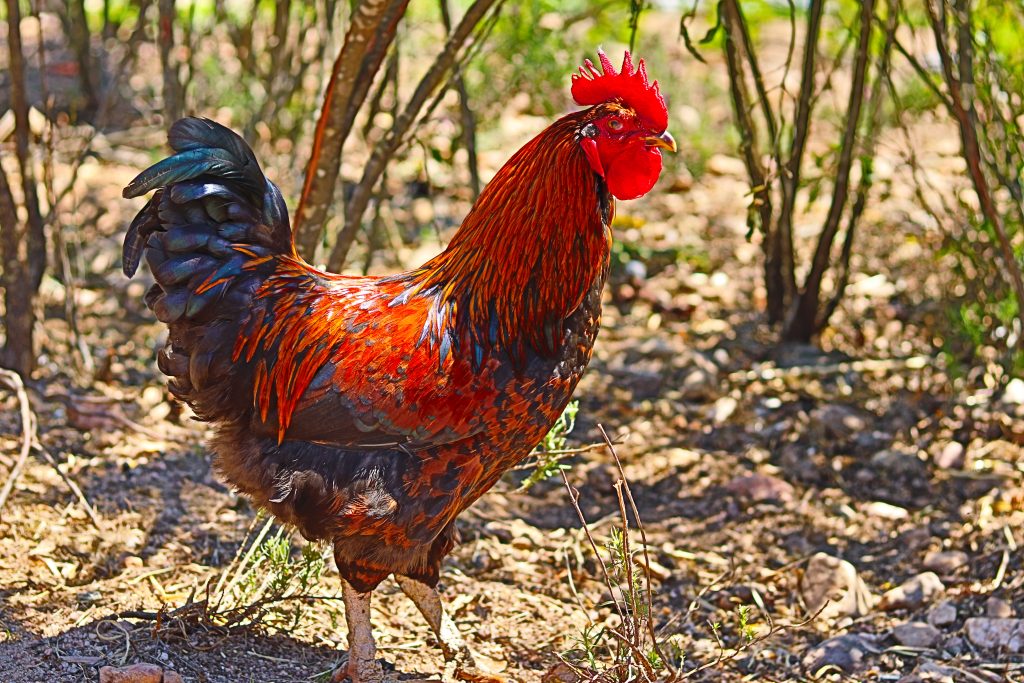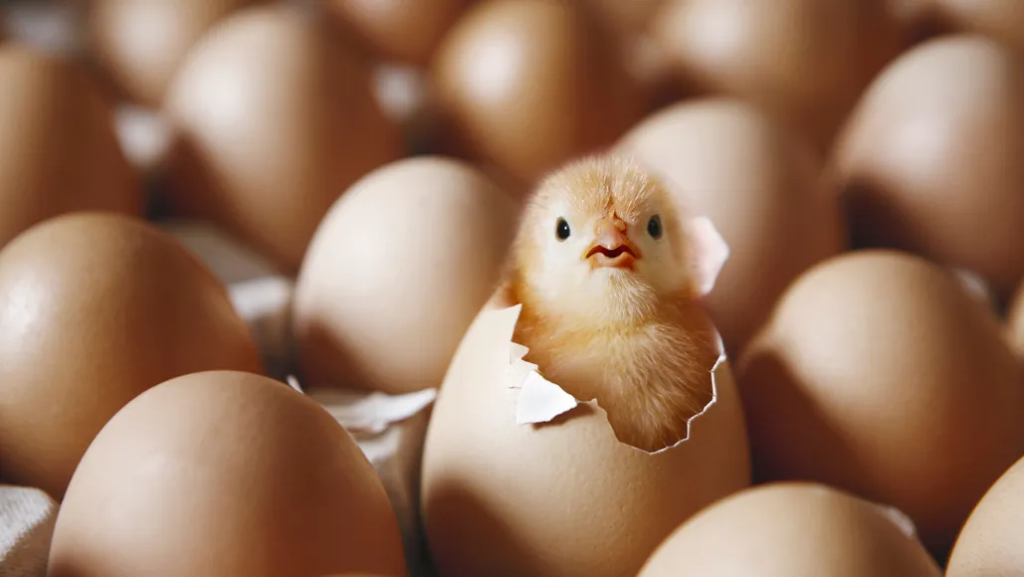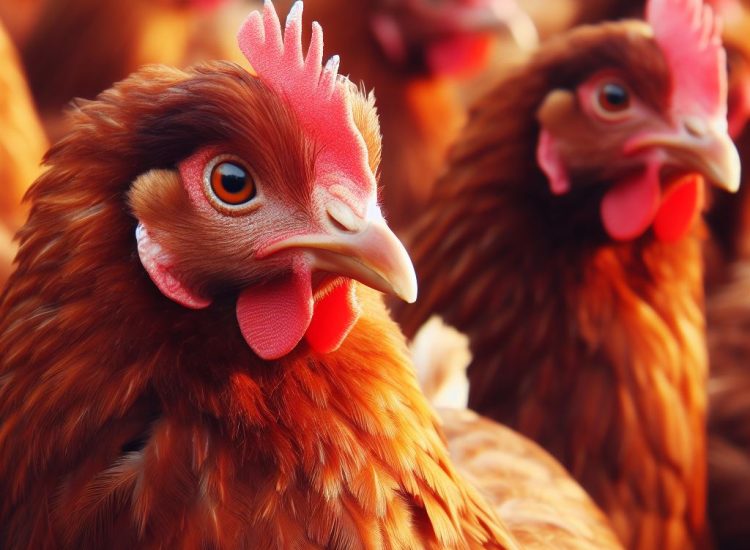Chickens are a low maintenance yet essential part of our farm, providing eggs, meat, manure and also brush-clearing.
Let’s start at beginning…
Picking The Breed
In many ways, Portugal remains a very old-school country, rural in the most traditional sense, with large percentage of its people still routinely growing their own vegetables and raising their own livestock.
Even driving through the cities, lush and productive vegetable plots punctuate the city-scape, and even in the very hearts of the metropolises, you will find paddocks of goats and sheep and even cows.
Fortunately for us, a dual chicken breed was not hard to come here–that is, a good table bird (meat) that is also a good egg layer. The super-charged egg layers Red Star (aka ISA Brown/Red Sex-Link, pictured below) are commonplace, with farm shops and local breeders alike routinely stocking them, and for dirt cheap, too.

Doubling as dual-purpose birds, maturing to approximately 8lbs (3.6kg), Red Stars are a great one-stop-shop.
They are bred from crosses, usually from a combination of White Plymouth Rock (white Rock), Rhode Island Reds, and Delawares. Hybridizing these already prolific layers gives you the super-charged Red Stars which lay on average 300+ large brown eggs a year.
The only downside is that two Red Star chickens will not breed true, meaning they will not produce sex-linked (the same type of) offspring. Breeding more Red Stars involves mating Rhode Island Reds with White Rocks, for example. While this is not a complex task, it is something to note.
Recently (since the above video was shot), we’ve let more of a natural ‘free-for-all’ take place on the farm.
We control the roosters, letting only Rhode Rhode Reds patrol the grounds, but as for the hens, all eggs are fertilized, not only those from our White Rocks — we breed combinations and crosses etc., with great results.
Our 50+ chickens provide us with an abundance of eggs, and the fattest/tastiest-looking get picked off, processed and eaten as and when required.
Feed and General Care
Our Red Stars (or similar crosses) are very easy to raise, and have a good feed-conversion ratio.
If space allows, the healthiest (and cheapest) option is to have chickens free-range on natural grasslands, with the varied plant species and juicy little critters that this provides. A varied diet is optimal.
But this needn’t call for the constructing of a huge multi-acre enclosure. For us, we cordon off our vegetable patches and growing areas (with high fences), and then allow our chooks to graze about our 8-acres.
This has the added benefit of protecting our veggies and grains from wild animals, such as rabbits, deer and boars; and makes keeping chickens effectively effort-free (but for the initial construction of a safe and sturdy hen house, which the hens happily lay their eggs in during the day and gratefully return to each night).
Chickens are excellent foragers. But as a top up, particularly in winter, we do designate growing areas for their feed. We grow corn for them, predominantly, but also some quinoa and sunflowers.
We simply toss a whole grain/seed head to the birds once or twice a day (stored on strings in one of our sheds).
Between harvests –particularly in our grain fields– we will let our chickens in (along with our goats and pigs) to feed on the leftovers. This, along with feeding the animals, also re-fertilizes the field ready for the next planting.
If feeding ‘traditionally’, a quality, ideally non-GMO feed is optimal.
Basic Healthcare And Upkeep
We clean our cook out weekly –making sure to compost everything– which helps keep disease and mites down.
Chickens are generally tough, hardy birds — they give us very few issues.
We’ve had the odd ‘egg bound’ hen, which is when an egg becomes stuck inside a hen’s oviduct. After 48-hours this is a life threatening condition and so requires intervention. We add electrolytes into the water, give the poorly hen a warm bath, and on one occasion, as a last ditch attempt, manually removed the egg.
Mites have been an issue from time to time. Treating these is easier but no less important. Mites feed on the chickens blood which can lead to all sorts of problems such as a compromised immune system and even death.
Mites may be seen crawling about the coop, but the most obvious sign will likely be clumps of the little critters and/or their eggs on the bird themselves, particularly around the base of the feathers under the wings.
To rid our flock of mites, we use a natural homemade spray consisting of garlic and lavender which gets squirted about the coop as well as on the chickens themselves.
While as a preventative measure, incorporating garlic into your chickens’ diet will go a great way to reducing parasite numbers as they don’t much like the taste of it in the blood.
Predators
Foxes. Foxes. Foxes. I hate them.
We lost 30+ chickens in one evening a few years back.
Two foxes scaled the 6-foot high fence (of our old enclosure) –didn’t know they could do that– and proceeded to bite the heads off ALL of our chickens, forcing us to start again. And this time I bought my first gun as well.
A sturdy coop was always our first port of call, to protect the hens at night. But these foxes came during early dusk, when the chooks were still out foraging. The pair of cunning gits used the cover of a big rain storm to attack, so that our little guard dog, still indoors with us at the time, wouldn’t be alerted.

People have suggested it was raccoons responsible, with their penchant for removing heads. But I know it was foxes, I saw them! And if I’d had a gun at the time I’d of been able to blow their heads off and seen how they liked it.
And…
…breathe.
In all seriousness, this is a key lesson we’ve learned re. life on a farm. There is no place for squeamishness or a hippy-dippy ‘love of all of Mother Nature’s creations’. No way. Foxes can go to hell. And while fencing and barbwire and sturdy coops all help, there’s nothing that better says ‘leave my chickens alone’ than a foxing rifle.
The Eggs
We collect our eggs from the coop each morning.
They total around 40, the majority of which are fertilized — I know this because I check a good many while preparing my favorite breakfast: fried eggs and bacon with avocado and tomatoes (fried in extra virgin olive oil — we’re sure to stay clear of those veg/seed oils).
The fertilization check is… well… easier to show:

What we’re looking at here is the ‘germ spot’, or the white spot on the yolk.
The infertile germ spot contains only the female’s cells and looks like a solid white dot, whereas in a fertile egg the germ spot contains both the female and male cells and forms what I call a halo.
Note: It’s perfectly healthy to eat a fertilized egg. While I’ll admit the thought of consuming a progressed egg is kind of gross, and I’ve had occasions where a veiny yolk has dropped into the frying, it is perfectly harmless (for you, that is, not so much the chick).
Storing Eggs
Eggs intended for consumption should not be washed and will last longest in the fridge.
Keeping the eggs at the back of the fridge will avoid the constant temperature changes that come with door openings, which will extend their use-by-date.
A cool pantry and/or root cellar is another great option, giving you as long as two months if you’re lucky.
Simply storing your eggs on the kitchen side is also perfectly acceptable, giving you around a fortnight.
Note: fertilized eggs stored above 34C/93F (but below 40.5C/105F) could continue developing.
Breeding, Incubating And Chicks
We aim to have one mature rooster for every 8-or-so hens.
Having a proper hen to rooster ratio in your flock will prevent rooster fights and keep the hens from becoming stressed out by too much ‘rooster attention’, let’s call it.

While we have had some luck in the past letting broody hens sit on the eggs, an incubator has proven far more reliable and consistent.
We purchased a quality 24-egg incubator by Borotto –after a few cheap-out failures– which, given a chicken’s egg incubation time of 21 days and a 80% loss rate, gives us approximately 19 new chicks a month.
Enough for our needs.

Newly hatched chicks require warmth, of course.
We have found heats plates to be best, over heat lamps — like this one. Their advantages are numerous: chicks can opt in or out, they us less energy, and they also have a reduced fire risk.

Baby chicks don’t require anything to eat or drink for 48-72 hours after hatching. These little fluff balls are sustained by the yolk of the egg, which they absorb into their body just before busting out of the shell.
A water dish should be on hand for your chicks’ first sup.
And with regards to their food, a simple –preferably homegrown– starter feed comprising of finely milled corn, wheat, peas and sunflowers (or the like) will do fine.
Wheat
After 4-or-so weeks, our chickens are allowed to venture outside proper to forage for themselves.
After 8-weeks, they are introduced to the main flock.
A Word On Processing
On average, we butcher and eat around 15 chickens a month.
Two are used in our Sunday roasts alone, while the rest are cooked and eaten cold for lunches.
The bones are saved and boiled down to make a hearty and healing broth. And all scraps either feed our little guard dog Dolly or go back to the chickens themselves.
I’ll have a more in-depth article on our culling and processing method linked here soon.
To Conclude
In short, I consider chickens an absolute must have on the farm.
They provide so much and ask for so little in return.


